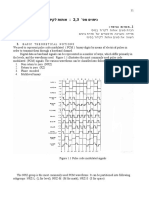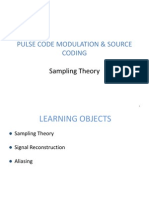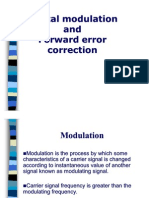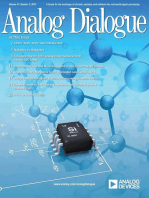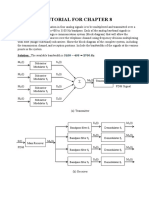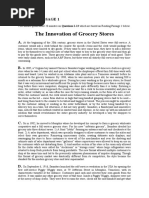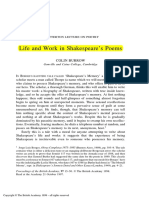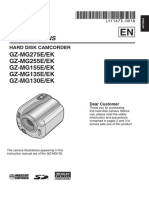93 TDM
93 TDM
Uploaded by
muhaned190Copyright:
Available Formats
93 TDM
93 TDM
Uploaded by
muhaned190Copyright
Available Formats
Share this document
Did you find this document useful?
Is this content inappropriate?
Copyright:
Available Formats
93 TDM
93 TDM
Uploaded by
muhaned190Copyright:
Available Formats
J.
1
Time-division multiplexing (TDM)
The method of combining several sampled signals in a
definite time sequence is called time-division multiplexing
(TDM).
TDM for PAM signals
Suppose we wish to time-multiplex two signals using PAM.
Digital logic circuitry is usually employed to implement the
timing operations.
Sampler
Sampler
Pulse
generator
Pulse
generator
LPF
Clock
PAM (TDM)
) (
1
t f
) (
2
t f
+
+
Commutator
J.2
The time-multiplexed PAM output is
Sampling rate
The sampling rate depends on the bandwidth of the signals.
For example, if the signals are low-pass and band-limited to
3kHz. The sampling theorem states that each must be
sampled at a rate no less than 6kHz. This requires a 12kHz
minimum clock rate for the two-channel system.
t
) (
1
t f
) (
2
t f
x
T
T
J.3
Transmission bandwidth
The time-multiplexed PAM signal can be sent out on a
line (baseband communications) or used to modulate a
transmitter (passband communications).
Theoretically, the bandwidth occupied by a pulse is infinite.
J.4
However, we are transmitting the information of the signals
( ), not the information of the pulses.
If the time spacing between adjacent samples is (In this
example, ), the minimum bandwidth is
.
) ( ), (
2 1
t f t f
x
T
2 / T T
x
=
) 2 /( 1
x x
T B =
J.5
For example, if the time-multiplexed PAM signal described
in J.4 is filtered with a low-pass filter with bandwidth
, the impulses become sinx/x terms.
Because we have chosen the spacing between successive
samples to be , contributions from all adjacent
channels are exactly zero at the correct sampling instant.
Therefore, by sampling the output at the correct instant, one
can exactly reconstruct the original sampled values
LPF
t
t
) 2 /( 1
x
B
) 2 /( 1
x x
B T =
) 2 /( 1
x
B
J.6
t
) (
1
t f
) (
2
t f
x
T
T
t
LPF
The results refer to the case in which impulse sampling and
ideal filtering. In practice, neither of these conditions can be
achieved and wider bandwidth is required.
The required bandwidth depends on the allowable cross-talk
(interference) between channels.
J.7
Receiver
Synchronization of the the clock and the commutator in the
time-multiplex receiver can be achieved by sending some
pre-assigned code which, when identified at the receiver,
serves to synchronize the timing.
Sampler
Sampler
Pulse
generator
Clock
) (t f
PAM
Commutator
LPF
LPF
) (
1
t f
) (
2
t f
Pulse
generator
J.8
After time multiplexing and filtering, the pulse-modulated
waveform may be transmitted directly on a pair of wire lines
For long distance transmission, the multiplexed signal is
used as the modulating signal to modulate a carrier.
For example, PAM/AM
PAM
multiplexer
Clock
AM
modulator
t
c
cos
AM
demodulator
t
c
cos
PAM
multiplexer
Clock
J.9
Advantages of TDM
high reliability and efficient operation as the circuitry
required is digital.
Relatively small interchannel cross-talk arising from
nonlinearities in the amplifiers that handle the signals in
the transmitter and receiver.
Disadvantages of TDM
timing jitter
J.10
Example
Channel 1 of a two-channel PAM system handles 0-8 kHz
signals; the second channel handles 0-10kHz signals. The
two channels are sampled at equal intervals of time using
very narrow pulses at the lowest frequency that is
theoretically adequate.
Sampler
Sampler
Pulse
generator
Pulse
generator
LPF
Clock
PAM (TDM)
) (
1
t f
) (
2
t f
+
+
Commutator
J.11
a) what is the minimum clock frequency of the PAM signal ?
The minimum sampling rate for channel 1 is 2B = 16kHz.
The minimum sampling rate for channel 2 is 20kHz.
In order to sample channel 2 adequately, we must take
samples at a 20kHz rate. Therefore the commutator clock
rate is 40kHz.
J.12
b) What is the minimum cutoff frequency of the low-pass filter
used before transmission that will preserve the amplitude
information on the output pulses ?
c) What would be the minimum bandwidth if these channel
were frequency multiplexed, using normal AM techniques
and SSB techniques ?
AM: 2*(bandwidth of channel 1) + 2*(bandwidth of
channel 2) = 2*8kHz + 2*10kHz = 36kHz
SSB: bandwidth of channel 1 + bandwidth of channel 2
= 8kHz + 10kHz = 18kHz
kHz T B
x x
20 ) 2 /( 1 =
J.13
d) Assume the signal in channel 1 is sin(5000t) and that in
channel 2 is sin(10000t). Sketch these signals; sketch the
waveshapes at the input to the first low-pass filter, at the
filter output, and at the output of the sample-and-hold circuit
and output of the low-pass filter in channel 2.
t
ms 4 . 0
) 5000 sin( t
t
ms 2 . 0
) 10000 sin( t
J.14
Sampling period = 1/(2*10kHz)=0.05ms
Multiplexed PAM:
Output of filter:
t
ms 4 . 0
ms 05 . 0
t
ms 05 . 0
ms 2 . 0
t
t
J.15
Output of holding circuit
for channel 2:
Output of low-pass filter:
t
t
J.16
Return-to-bias (RB) method
Three levels are used: 0,1, and a bias level.
Bias level may be chosen either below or between the
other two levels.
The waveform returns to the bias level during the last half
of each bit interval.
The RB method has an advantage in being self-clocking.
1 1 1 0 0 1 PCM code
RB
Example:
1 ==> A volts
0 ==> -A volts
Line coding
J.17
Unipolar Return-to-zero (RZ) method
Digit 1 is represented by a change to the 1 level for one-half the
bit interval, after which the signal returns to the reference level for
the remaining half-bit interval.
Digit 0 is indicated by no change, the signal remaining at the
reference level.
Its disadvantage is that it requires 3dB more power than RB
signaling (or AMI) for the same probability of symbol error.
An attractive feature of this line code is the presence of delta
function at f=1/T
b
in the power spectrum of the transmitted signal,
which can be used for bit-timing recovery at the receiver.
J.18
1 1 1 0 0 1 PCM code
RZ
RB
T
b
:Bit duration
Decision boundary
J.19
power spectrum of Unipolar RZ signaling. The
normalized frequency is 1/T
b
J.20
Alternate Mark Inversion (AMI)
The first 1 is represented by +1, the second 1 by -1,
the third 1 by +1, etc.
has zero average value and relatively insignificant low-
frequency components
used in telephone PCM systems.
Also referred to as a bipolar return-to-zero (BRZ)
representation.
1 1 1 0 0 1
PCM code
AMI
J.21
Power spectrum of AMI signaling
J.22
Spilt phase
eliminates the variation in average value using symmetry.
In the Manchester split-phase method
A 1 is represented by a 1 level during the first half-bit interval,
then shifted to 0 level for the latter half-bit interval
A 0 is indicated by the reverse representation.
The manchester code suppresses the DC component and has
relatively insignificant low-frequency components.
In the split-phase (mark) method, a similar symmetric
representation is used except that a phase reversal relative to the
previous phase indicates a 1 and no change is used to indicate a
0.
J.23
1 1 1 0 0 1
PCM code
Split-phase
(Manchester)
Split-phase
(mark)
J.24
Power spectrum of Manchester code signaling
J.25
Nonreturn-to-zero
reduce the bandwidth needed to send the PCM code.
In the NRZ(L) representation, a bit pulse remains in one of its two
levels for the entire bit interval.
In the NRZ(M) method a level change is used to indicate a 1 and
no level change for a 0.
In the NRZ(S) method a level change is used to indicate a 0 and
no level change for a 1.
NRZ representations require added receiver complexity to
determine the clock frequency.
1 1 1 0 0 1 PCM code
NRZ (L)
NRZ (M)
NRZ (S)
Delay Modulation
(Miller code)
J.26
Delay modulation (Miller code)
a 1 is represented by a signal transition at the midpoint
of a bit interval. A 0 is represented by no transition
unless it is followed by another 0, in which case the
signal transition occurs at the end of the bit interval.
1 1 1 0 0 1 PCM code
NRZ (L)
NRZ (M)
NRZ (S)
Delay Modulation
(Miller code)
J.27
Power spectrum of NRZ(L)
J.28
Transmission bandwidth
The fundamental frequency of a binary code stream depends on its most rapidly varying
pattern.
Example: 111 for RZ and NRZ(M)
For a binary PCM system with n quantization levels, the number of bits per sample is
If the sample rate be 1/T, then the number of bits per second to be sent is
The minimum bandwidth is
(NRZ) (RZ)
1 1 1 1 1 1
b
T
b
T
b o
T f / 1 =
b o
T f 2 / 1 =
| | n
2
log
(the brackets indicate the next higher integer to be taken, e.g. if n=7, we use 3 bits)
| | T n / log
2
| |
|
.
|
\
|
T
n
B
2
log
2
1
| |
T
n
B
2
log
J.29
In baseband transmission, the bit stream described in N.1-N.8 are sent on a transmission
line.
In passband transmission, the bit stream is used to modulate a high frequency carrier.
Amplitude-shift keying (ASK): the amplitude of a carrier is switched between two
values in response to the PCM code.
Frequency-shift keying (FSK): the frequency of a carrier is switched between two
values in response to the PCM code.
Phase-shift keying (PSK): the phase of a carrier is switched between two values in
response to the PCM code.
1 1 1 0 0 1 PCM code
NRZ (L)
ASK
FSK
PSK
change of phase
J.30
PSK and FSK are preferred to ASK signals for passband
data transmission over nonlinear channel such as
micorwave link and satellite channels.
Coherent and Noncoherent
Digital modulation techniques are classified into coherent
and noncoherent techniques, depending on whether the
receiver is equipped with a phase-recovery circuit or not.
The phase-recovery circuit ensures that the local oscillator
in the receiver is synchronized to the incoming carrier
wave (in both frequency and phase).
J.31
Coherent PSK
The functional model of passband data transmission system is
m
i
is the binary sequence.
In a coherent binary PSK system, the pair of signals and used to represent
binary symbols 1 and 0, respectively, is defined by
where , and is the transmitted signal energy per bit.
Modulator
Signal
transmission
encoder
i
m
Carrier signal
) (t s
i
Channel
) (t x
Detector
i
s
x
Signal
transmission
decoder
m
) (
1
t s
) (
2
t s
) 2 cos(
2
) (
1
t f
T
E
t s
c
b
b
=
) 2 cos(
2
) 2 cos(
2
) (
2
t f
T
E
t f
T
E
t s
c
b
b
c
b
b
= + =
b
T t 0
b
E
J.32
For example,
To ensure that each transmitted bit contains an integral number of cycles of the carrier
wave, the carrier frequency is chosen equal to for some fixed integer n.
The transmitted signal can be written as
and
where
| |
b
b
b
b
T
c
b
b
T
E
T
T
E
dt t f
T
E
dt t s E
b b
= = = =
2
2
) 2 ( cos
2
) (
0
2
0
2
1
c
f
b
T n/
) ( ) (
1
t E t s
b
=
) ( ) (
2
t E t s
b
=
b c
b
b
T t t f
T
t < = 0 ) 2 cos(
2
) (
) 2 cos(
2
) (
) 2 cos(
2
) 2 cos(
2
) (
1
1
n
T
E
T s
t
T
n
T
E
t f
T
E
t s
b
b
b
b b
b
c
b
b
=
= =
J.33
Generation of coherent binary PSK signals
To generate a binary PSK signal, we have to represent the
input binary sequence in polar form with symbols 1 and 0
represented by constant amplitude levels of
b
E + and
b
E , respectively.
This signal transmission encoder is performed by a
polar nonreturn-to-zero (NRZ) encoder.
The carrier frequency
b c
T n f / = where n is a fixed
integer.
+
=
0 is symbol input
1 is symbol input
b
b
i
E
E
s
= =
= =
=
b i c
b
b
b i c
b
b
i
E s t f
T
E
t s
E s t f
T
E
t s
t s
if ) 2 cos(
2
) (
if ) 2 cos(
2
) (
) (
2
1
J.34
Product
Modulator
Signal
transmission
encoder
10101
i
s
) 2 cos(
2
) ( t f
T
t
c
b
=
) (t s
i
J.35
Detection of coherent binary PSK signals
To detect the original binary sequence of 1s and 0s, we
apply the noisy PSK signal to a correlator. The correlator
output is compared with a threshold of zero volts.
b
T
0
) (t x
) (t
Correlator
X
1
x
Decision
device
0
if 0
if 1
1
1
x
x
J.36
Example: If the transmitted symbol is 1,
) 2 cos(
2
) ( t f
T
E
t x
c
b
b
=
and the correlator output is
b
T
c
b
b
T
c
b
c
b
b
T
E
dt t f
T
E
dt t f
T
t f
T
E
dt t t x x
b
b
b
=
=
=
=
0
2
0
0
1
) 2 ( cos
2
) 2 cos(
2
) 2 cos(
2
) ( ) (
Similarly, If the transmitted symbol is 0,
b
E x =
1
.
J.37
Delta Modulation (DM) and Differential Pulse Code Modulation (DPCM)
Reference
Stremler, Communication Systems, Chapter 9.7
Delta Pulse Code Modulation (DPCM)
In the transmission of messages having repeated sample values, the repeated
transmission represents a waste of communication capability because there is
little information content in the repeated values.
In DPCM, only the digitally encoded difference between successive sample
values. Therefore, the number of bit can be reduced.
Example: a picture that has been quantized to 6 bits can be transmitted with
comparable quality using 4-bit DPCM.
J.38
LPF
) (t f
Decoder
Clock/
Sampler
Quantizer-
encoder
+
-
DPCM
Decoder
LPF
DPCM
) (t f
) (t f
) (t f
LP
) (t f
LP
t
t
) (t g
) (t f
delay
) ( ) ( T t f t f
LP delay
) ( ) ( ) ( t f t f t g
delay LP
=
t
Range of > Range of
) (t f
) (t g
J.39
Delta Modulation (DM)
In delta modulation (DM), an incoming signal is oversampled (i.e. at a rate much
higher than the Nyquist rate) to purposely increase the correlation between
adjacent samples of the signal.
The difference between the input and the approximation is quantized into two
levels:
> +
> + +
= +
) ( ) ( if ) (
) ( ) ( if ) (
) (
nT f T nT f nT f
nT f T nT f nT f
T nT f
q q
q q
q
) ( T nT f +
Delay T
Quantizer
+
-
+
+
Encoder
) (nT f
q
) ( T nT f
q
+
DM
Accumulator
J.40
Disadvantages
If the input signal level remains constant, the reconstructed DMwaveform
exhibits a hunting behavior known as idling noise.
Slope-overload
) (t f
t
t
0 1 0 1 1 0 1 0 1 1 1 1 1 0 1
Idling noise
Slope-overload
You might also like
- Pure Sine Wave Inverter Manual PDFDocument13 pagesPure Sine Wave Inverter Manual PDFmuhaned190100% (2)
- Digital CommunicationDocument16 pagesDigital CommunicationAli Najim Al-AskariNo ratings yet
- Exp. PCMDocument9 pagesExp. PCMsairajdreamNo ratings yet
- Al-Balqa' Applied University Faculty of Engineering TechnologyDocument6 pagesAl-Balqa' Applied University Faculty of Engineering TechnologyM OdehNo ratings yet
- PCM (Pulse code modulation) : -Teacher: Masters Nguyễn Thanh Đức -Group memberDocument77 pagesPCM (Pulse code modulation) : -Teacher: Masters Nguyễn Thanh Đức -Group memberTao Thích Màu ĐenNo ratings yet
- Comm. Sys. Lect. 10Document21 pagesComm. Sys. Lect. 10sulllNo ratings yet
- 3 MULTIPLEXING Part1Document34 pages3 MULTIPLEXING Part1Brian Edward HarrisNo ratings yet
- Principal of Electronics Communication LabDocument21 pagesPrincipal of Electronics Communication Labrahulsinha8591No ratings yet
- EE 3206, Exp 03Document3 pagesEE 3206, Exp 03Tahsin Zaman TalhaNo ratings yet
- Signal Encoding TechniquesDocument34 pagesSignal Encoding TechniquesJitendra PatelNo ratings yet
- Comm Chptr4Document53 pagesComm Chptr4Muhamad Fuad100% (1)
- Digital Transmission Through AWGN ChannelDocument68 pagesDigital Transmission Through AWGN Channelkhadeja albayatyNo ratings yet
- Digital Communication RecordDocument46 pagesDigital Communication Recordathavan12tc08No ratings yet
- RZ AmiDocument13 pagesRZ AmiJorge Deza ConcoriNo ratings yet
- VLC Communication B-10Document10 pagesVLC Communication B-10Pavan KumarNo ratings yet
- Lec PU March05Document98 pagesLec PU March05Muhammad Awais AshfaqNo ratings yet
- Signal Encoding and Modulation TechniquesDocument21 pagesSignal Encoding and Modulation Techniqueschetanajitesh76No ratings yet
- 2 WC Modulation SchemesDocument33 pages2 WC Modulation Schemesanand.naman69No ratings yet
- PCM BahaaDocument50 pagesPCM BahaaNazar liveNo ratings yet
- RZ AmiDocument13 pagesRZ AmiCarlos Andres Arias LopezNo ratings yet
- Chap6 JhchenDocument43 pagesChap6 Jhchenchetanajitesh76No ratings yet
- On The Linear Representation of GMSK ModulationDocument14 pagesOn The Linear Representation of GMSK ModulationIvanoNo ratings yet
- 2024-06-28 07 - 09 - 24.099 - 1Document16 pages2024-06-28 07 - 09 - 24.099 - 1cp830652No ratings yet
- Poc FormulaDocument5 pagesPoc FormulaShivika SharmaNo ratings yet
- Sampling Process: The Process of Transforming An Analog Waveform Into A Discrete Waveform IsDocument7 pagesSampling Process: The Process of Transforming An Analog Waveform Into A Discrete Waveform IsShubham ManteNo ratings yet
- Week 3 1 PDFDocument33 pagesWeek 3 1 PDFosmanriazNo ratings yet
- Modulation Schemes: Lecturer: DR Iryna KhodasevychDocument42 pagesModulation Schemes: Lecturer: DR Iryna KhodasevychBilalNo ratings yet
- PCM in The Bell System Multiplexing PCM Asynchronous PCM Extensions To PCMDocument20 pagesPCM in The Bell System Multiplexing PCM Asynchronous PCM Extensions To PCMjeumNo ratings yet
- DC Lab ManualDocument24 pagesDC Lab Manualvidyae100% (2)
- Digital Modulation TechniquesDocument97 pagesDigital Modulation Techniquesharshalatre2No ratings yet
- Tutorial 4-SolutionDocument11 pagesTutorial 4-SolutionZaidi Mat ZainuddinNo ratings yet
- PCM Tta BatchDocument84 pagesPCM Tta BatchGourav RoyNo ratings yet
- A Broadband Cmos Multiplier-Based Correlator For Ir-Uwb Transceiver SocDocument4 pagesA Broadband Cmos Multiplier-Based Correlator For Ir-Uwb Transceiver SocmiracuNo ratings yet
- Line Coding: Self-SynchronisationDocument12 pagesLine Coding: Self-SynchronisationKenny Samaroo100% (1)
- Presentation On Digital Modulation and Forward Error CorrectionDocument74 pagesPresentation On Digital Modulation and Forward Error CorrectionJitendra Chuugh100% (1)
- Amplitude Modulation NithinDocument15 pagesAmplitude Modulation NithinNithindev GuttikondaNo ratings yet
- Department of Electronics and Communication Engineering EC 3012 Digital Communication-Monsoon 2015Document3 pagesDepartment of Electronics and Communication Engineering EC 3012 Digital Communication-Monsoon 2015shreyas_stinsonNo ratings yet
- Chapter 9Document25 pagesChapter 9aasm4152No ratings yet
- AD and DA Converter PrinciplesDocument18 pagesAD and DA Converter PrincipleskarkeraNo ratings yet
- PCM PrinciplesDocument45 pagesPCM PrinciplesKapil BhutaniNo ratings yet
- NT Old QuestionsDocument64 pagesNT Old QuestionsSomya SinghNo ratings yet
- Lecture Note8b Summer0203Document13 pagesLecture Note8b Summer0203Melaku DinkuNo ratings yet
- QB 2Document10 pagesQB 2Abhishek RaoNo ratings yet
- QB 2Document10 pagesQB 2Abhishek RaoNo ratings yet
- Analog and Digital CommunicationDocument11 pagesAnalog and Digital CommunicationKarthi KeyanNo ratings yet
- CT2 - Unit2 - A Sec - PPT - 38 PagesDocument38 pagesCT2 - Unit2 - A Sec - PPT - 38 PagesJagrit DusejaNo ratings yet
- By, Ansa Tom Roll No: 2Document21 pagesBy, Ansa Tom Roll No: 2Divya KnNo ratings yet
- Problemas Parte I Comunicaciones DigitalesDocument17 pagesProblemas Parte I Comunicaciones DigitalesNano GomeshNo ratings yet
- Digital Communications - Fundamentals & Applications (Q0) PDFDocument39 pagesDigital Communications - Fundamentals & Applications (Q0) PDFMohamd barcaNo ratings yet
- EE370 Final 091Document6 pagesEE370 Final 091thinkberry22No ratings yet
- Communication EngineeringDocument16 pagesCommunication EngineeringJesse VincentNo ratings yet
- Chapter 4 - Part 1-Digital Modulation (w1w2)Document40 pagesChapter 4 - Part 1-Digital Modulation (w1w2)Karl Neil Jay AgnoNo ratings yet
- T2 RegularDocument3 pagesT2 Regularf20221516No ratings yet
- Waveform Coding Techniques: Chapter-3Document33 pagesWaveform Coding Techniques: Chapter-3Ranbir FrostbornNo ratings yet
- Chapter 3 Ecm413 PDFDocument57 pagesChapter 3 Ecm413 PDFCaha yANo ratings yet
- DC Module 2 (my notes)Document13 pagesDC Module 2 (my notes)hajiraa.2903No ratings yet
- Fundamentals of Electronics 3: Discrete-time Signals and Systems, and Quantized Level SystemsFrom EverandFundamentals of Electronics 3: Discrete-time Signals and Systems, and Quantized Level SystemsNo ratings yet
- Analysis and Design of Multicell DC/DC Converters Using Vectorized ModelsFrom EverandAnalysis and Design of Multicell DC/DC Converters Using Vectorized ModelsNo ratings yet
- Arduino Solar Battery Charge ControllerDocument5 pagesArduino Solar Battery Charge Controllermuhaned190No ratings yet
- Jessel Arduino FinalDocument14 pagesJessel Arduino Finalmuhaned190No ratings yet
- Newbie's Guide To AVR Interrupts: Dean CameraDocument10 pagesNewbie's Guide To AVR Interrupts: Dean Cameramuhaned190No ratings yet
- Arduino: Attachinterrupt (Interrupt, Function, Mode)Document2 pagesArduino: Attachinterrupt (Interrupt, Function, Mode)muhaned190No ratings yet
- 08 2011 TingDocument18 pages08 2011 Tingmuhaned190No ratings yet
- How To Set Up Your Arduino To Blink An LED With A Switch Key PointsDocument5 pagesHow To Set Up Your Arduino To Blink An LED With A Switch Key Pointsmuhaned190No ratings yet
- Don Coleman Connecting Arduino Phones With Bluetooth Cordova PDFDocument56 pagesDon Coleman Connecting Arduino Phones With Bluetooth Cordova PDFmuhaned190No ratings yet
- Inverter Basics 8-13-09 PDFDocument4 pagesInverter Basics 8-13-09 PDFmuhaned190No ratings yet
- Triangle-Wave Generator (TWG) Outputs Both Triangle and Square Waves. Twgs AreDocument16 pagesTriangle-Wave Generator (TWG) Outputs Both Triangle and Square Waves. Twgs Aremuhaned190No ratings yet
- ULN200 X ADocument13 pagesULN200 X AmaurosergiorovettaNo ratings yet
- Features: Basic 4-Axis Motion Control Card With Multi Latch/Compare Trigger FunctionDocument1 pageFeatures: Basic 4-Axis Motion Control Card With Multi Latch/Compare Trigger Functionmuhaned190No ratings yet
- Maestro Multi Axis MotionDocument4 pagesMaestro Multi Axis Motionmuhaned190No ratings yet
- DS Pci-1245lio En20170927100542Document1 pageDS Pci-1245lio En20170927100542muhaned190No ratings yet
- Adt 8940a1 User Manual PDFDocument104 pagesAdt 8940a1 User Manual PDFmuhaned190No ratings yet
- 02212013102109Document5 pages02212013102109Hunain AKNo ratings yet
- Electronic Devices and Integrated Circuits - Operational Amplifier - SOLVED PROBLEMS - Safari Books OnlineDocument34 pagesElectronic Devices and Integrated Circuits - Operational Amplifier - SOLVED PROBLEMS - Safari Books Onlinemuhaned190100% (1)
- Academic Reading Test 2Document11 pagesAcademic Reading Test 2TurningPoint JindNo ratings yet
- Disaster Risk Reduction and Management: Standard Operating ProceduresDocument26 pagesDisaster Risk Reduction and Management: Standard Operating ProceduresVALIANT NAJIB ERESUELANo ratings yet
- Scoured StarsDocument263 pagesScoured StarsMagi ScytheNo ratings yet
- Animal AdaptationsDocument20 pagesAnimal AdaptationsPaariVallal BalaNo ratings yet
- Asian RegionalismDocument14 pagesAsian RegionalismJennyvie CabayaNo ratings yet
- Architectural Design 1Document30 pagesArchitectural Design 1Anshe ObispoNo ratings yet
- Ch. 18 - Adaptive Specific Host Defenses Chapter OutlineDocument11 pagesCh. 18 - Adaptive Specific Host Defenses Chapter Outlineezekielelijah124No ratings yet
- Electrical Engineering Third Year SyllabusDocument32 pagesElectrical Engineering Third Year Syllabus123vidyaNo ratings yet
- Armored Warrior IrisDocument1 pageArmored Warrior IrisIlham Leo Cibi CarbonexNo ratings yet
- Life and Work in Shakespeare's PoemsDocument36 pagesLife and Work in Shakespeare's PoemsshivnairNo ratings yet
- Sectioning PDFDocument31 pagesSectioning PDFRicardo Rincon Vega100% (1)
- Data Science in Agriculture Part I: IntroductionDocument2 pagesData Science in Agriculture Part I: Introductions8nd11d UNINo ratings yet
- Raman TutorialDocument17 pagesRaman TutorialDebashish SahaNo ratings yet
- Photobucket - Index of CollectionsDocument19 pagesPhotobucket - Index of CollectionsRobert CathcartNo ratings yet
- Slip Type Elevator Cat. IVDocument2 pagesSlip Type Elevator Cat. IVRanjithNo ratings yet
- AKUNTANSI HIJAU BERBASIS ETIKA BISNIS IMPLEMENTASI Di Rsua Ponorogo Jatim PDFDocument10 pagesAKUNTANSI HIJAU BERBASIS ETIKA BISNIS IMPLEMENTASI Di Rsua Ponorogo Jatim PDFIntan PratiwiNo ratings yet
- KenmoreElite (2.2 Cu. FT)Document33 pagesKenmoreElite (2.2 Cu. FT)QuincyJClarkeNo ratings yet
- 9th Class Maths Notes CH 14Document16 pages9th Class Maths Notes CH 14itsnotyourrangeNo ratings yet
- GlaucomeaDocument21 pagesGlaucomeamalathiNo ratings yet
- JVC GZ Mg130e Ek Users Manual 319907 PDFDocument84 pagesJVC GZ Mg130e Ek Users Manual 319907 PDFjajanayaNo ratings yet
- Genetics Powerpoint JPDocument31 pagesGenetics Powerpoint JPm w100% (1)
- ND PreDocument23 pagesND PrejohnNo ratings yet
- Lidar-Histogram For Fast Road and Obstacle DetectionDocument6 pagesLidar-Histogram For Fast Road and Obstacle Detection花样吃鸡刘水水No ratings yet
- Evaluation and prediction of transportation resilience under extreme weather events A diffusion graph convolutional approachDocument20 pagesEvaluation and prediction of transportation resilience under extreme weather events A diffusion graph convolutional approachmexujinhuaNo ratings yet
- Sample CopywritingDocument5 pagesSample CopywritingSleeptalker CullenNo ratings yet
- Air Inlet and Exhaust System: Systems OperationDocument5 pagesAir Inlet and Exhaust System: Systems OperationAhmed RezkNo ratings yet
- CWTS ProposalDocument4 pagesCWTS ProposalRommel M. Quiped100% (1)
- Columbus Mckinnon 456923 1Document108 pagesColumbus Mckinnon 456923 1MasterrNo ratings yet
- AP Biology Lab 6 TransformationDocument3 pagesAP Biology Lab 6 TransformationLogan GreenNo ratings yet
- Republic of KenyaDocument181 pagesRepublic of KenyaDERICK YINDANo ratings yet













